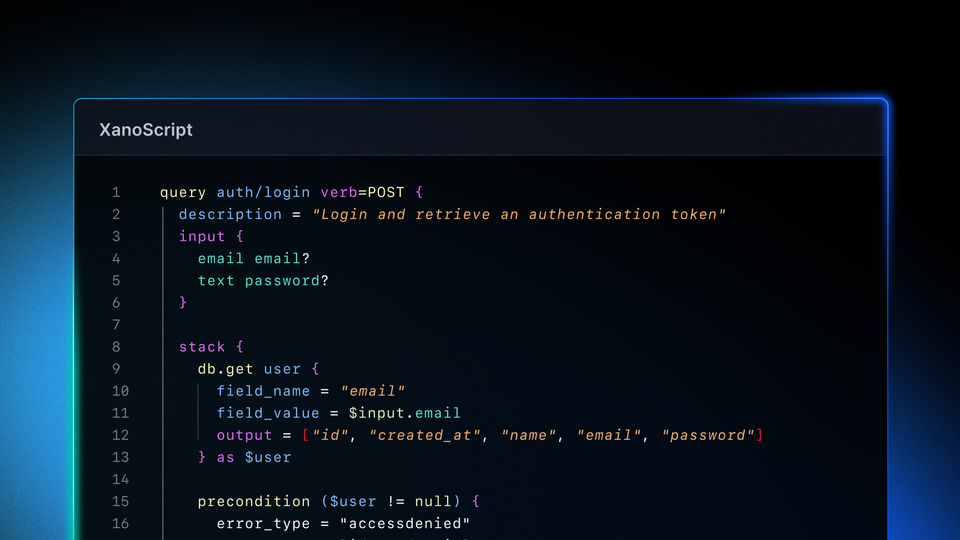Introducing XanoScript: A New Way to Build Your Backend

As application development evolves and, with the help of AI, becomes increasingly democratized, the lines between no-code, low-code, and standard development continue to blur. Development teams today are often a mix of builders — some who love the speed and clarity of visual development, and others who prefer the precision and expressiveness of code.
In recognition of this trend, and in an effort to meet all of our users where they are, we’re excited to announce XanoScript: a new, code-based way to interact with your Xano projects. However, XanoScript is not just any scripting language. We created it in a way that allows us to double-down on our commitment to visual development, while also making it possible for developers — or AI — to build in an IDE. XanoScript is designed so that you can write code, but also make sure that code enforces a strict, predictable structure that mirrors Xano’s visual builder one-to-one. The result? Everything coded in XanoScript can be perfectly represented visually, and vice versa—assuring the same level of standardization that exists visually, and forcing consistency while also making it easier for users to build confidently and maintain that code easily.
“As a traditional developer, the Function Stack is great, but XanoScript fills that missing piece. It lets me handle more complex logic, and I can easily copy and paste code just like I would in Visual Studio.” — Damon Brooks, CEO at Brooks Information Technologies
Below, we’ve put together answers to a few of the most common questions about how XanoScript fits into the platform and what it means for teams building with Xano.
What is XanoScript, and why did Xano create it?
XanoScript extends Xano’s capabilities by adding a scriptable layer that complements the visual builder you already know. It gives every member of a team — whether they prefer visual tools, code, or AI-assisted workflows — the ability to build in the way that works best for them.
And when we refer to “members of a team” — we can’t leave out AI. As AI becomes an active participant in the software creation process, all platforms need a structured language that AI systems can understand, generate, and reason about. XanoScript provides that foundation — helping both humans and AI build faster and more intelligently together.
The beauty of XanoScript is that it gives you the choice to build in the way that you prefer. If you want to stick with visual development, you can. But if you want to build your complete backend in your IDE (or let AI help you with it), you can do that too. In other words, XanoScript lets anyone, including AI, access the full power of Xano.
Why did Xano create its own language instead of using something like TypeScript or HCL?
When we set out to make Xano scriptable, we could have adopted an existing language like TypeScript, or a configuration language like HCL. Instead, we built XanoScript to be purpose-fit for the Xano ecosystem.
TypeScript is designed for full-scale application development, which offers flexibility — but also introduces complexity that can break the clean, one-to-one relationship between code and visual logic. XanoScript is different: it’s a configuration language purpose-built for Xano. It is structured, predictable, and it mirrors the visual builder exactly, ensuring complete consistency between what’s written and what’s seen.
We also considered HCL (HashiCorp Configuration Language). As a configuration language, it is certainly closer to XanoScript than TypeScript is. However, it also has limitations. Specifically, it’s specialized for static Infrastructure as Code, and XanoScript needed to handle dynamic business logic, database schemas, and visual mapping, all while being optimized for AI-assisted development. In other words, we required a configuration language that could both define and execute.
The solution, we felt, was clear: We needed something new. With XanoScript, we have a scripting language that perfectly represents visual development and is ideal for AI generation, while also offering a unified foundation across the Xano platform — spanning business logic, database schemas, and microservices and MCP server configurations.
In short, XanoScript delivers the standardization of visual development with the power of code — without compromising either.
How does XanoScript make the Xano experience better?
XanoScript enhances what’s already great about building in Xano. It gives teams a transparent view of what’s being built, improves collaboration between technical and nontechnical members, and introduces features like Git integration, version control, and auditing.
It also makes complex backends easier to understand and maintain. Whether you’re reviewing a teammate’s work, debugging an API, or syncing with AI-generated logic, XanoScript provides a clear, structured way to see exactly how everything fits together.
Is XanoScript changing how visual development works in Xano?
Not at all. In fact, XanoScript strengthens our commitment to visual development — one of Xano’s core differentiators. Visual building remains at the heart of the platform and will continue to be a primary way our users build, iterate, and launch backends.
XanoScript simply adds flexibility. It allows technical users and AI systems to interact with the same visual logic in code form — bringing greater transparency, auditability, and speed to the process. Visual development remains central to Xano’s mission; XanoScript just extends its reach.
How does XanoScript maintain reliability and consistency across teams?
Because XanoScript is tightly structured and directly linked to the visual builder, it carries the same safeguards that make Xano so reliable. Every change made in XanoScript syncs automatically with the Visual Canvas and Function Stack — so there’s no risk of code drift or unapproved logic.
The result is a consistent, disciplined development process where teams can build safely and confidently. XanoScript provides visibility, guardrails, and structure — helping ensure that every project stays clean, consistent, and scalable as it grows.
The bottom line
XanoScript represents the next evolution of backend development — a world where building visually, building with code, and building with AI coexist seamlessly. It’s designed for teams that want to move faster, collaborate more effectively, and prepare for the next wave of intelligent, AI-assisted development.
This isn’t a departure from Xano’s mission — it’s a continuation of it. We’re making sure that no matter how you build, Xano continues to be the most flexible, scalable, and forward-looking backend for turning ideas into production-ready, scalable apps.
Want to see XanoScript in action? Learn more in the Xano 2.0 webinar, or (even better!) try Xano for free.




